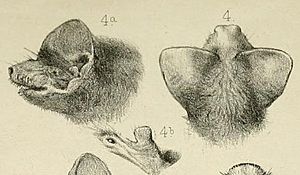East-coast free-tailed bat facts for kids
Quick facts for kids East-coast free-tailed bat |
|
|---|---|
 |
|
| Conservation status | |
| Scientific classification | |
| Synonyms | |
|
The East-coast free-tailed bat (scientific name: Micronomus norfolkensis) is a type of bat found only in Australia. It belongs to a group of bats called molossids, also known as free-tailed bats. These bats live in southeastern Queensland and eastern New South Wales. The East-coast free-tailed bat is the only species in its group, called Micronomus.
Contents
What is the East-coast Free-tailed Bat?
This bat is often called the east-coast free-tailed bat or eastern coastal free-tailed bat. Other names include eastern little mastiff bat. Its scientific name, Micronomus norfolkensis, was given by John Edward Gray in 1839. The "norfolkensis" part comes from Norfolk Island, where people first thought the bat was found.
What Does This Bat Look Like?
The East-coast free-tailed bat has fur that can be dark brown or reddish-brown. Its belly is usually a lighter color than its back.
Where Do These Bats Live?
These bats have been seen in different types of forests. They live in dry eucalypt forests and wet sclerophyll forests. They also like riparian rainforests, which are forests near rivers.
Sometimes, a group of these bats has been found roosting (resting) inside a house. Female bats with their young have also been seen resting in grey mangrove forests.
What Do We Know About Their Lives?
Scientists haven't studied the East-coast free-tailed bat very much. This means we don't know a lot about how they live or what they do every day. Even though they might sometimes rest together in groups, they are usually found alone.
How Are We Protecting Them?
It is believed that there are about 10,000 to 11,000 adult East-coast free-tailed bats left. They face some dangers that could reduce their numbers. These dangers include losing their homes because of logging (cutting down trees) and building new developments along the coast. Changes to natural fire patterns in their habitats can also be a threat.
See also
 In Spanish: Mormopterus norfolkensis para niños
In Spanish: Mormopterus norfolkensis para niños


